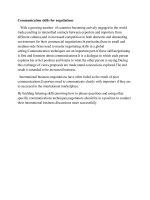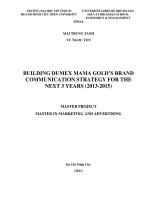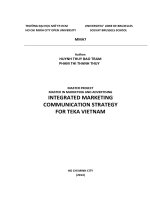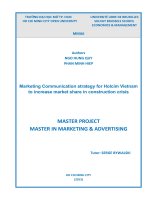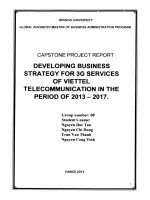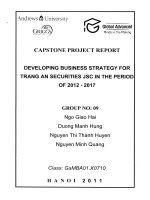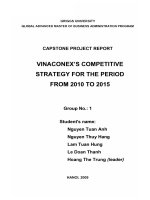Communication Strategy for High-Tech Products
Bạn đang xem bản rút gọn của tài liệu. Xem và tải ngay bản đầy đủ của tài liệu tại đây (168.22 KB, 22 trang )
Communication Strategy for
High-Tech Products
Investing in marketing communication, or “marcom,” is one of
the secrets of the high-tech firms that seem to flourish during
the economic downturns. While most of their competitors cut
on communication costs in order to save money, the successful
firms increase their communication to grow their market
share. That does not mean to expand their advertising budget
drastically. To be sure, some large companies spend heavily in
advertising to knock down their competitors. Table 8.1 intro-
duces the biggest communication spenders in the United
States. To this list, one could add Samsung Electronics, which
launched a $400 million global ad campaign in 2002 with $70
million for the North American market.
However, the sheer volume of money is not the ultimate
indicator of performance; some highly successful companies
have managed to achieve recognition through creativity and
publicity. One of the most famous high-tech brands in 2003
was Google, the well-recognized Web search engine that has
achieved this position mostly through word of mouth and
quality. Amazon, eBay, and Yahoo have also achieved immedi
-
ate recognition on low advertising budgets. Those Web-based
firms have managed better than their competitors to ride the
wave of the Internet. They have been able to generate buzz
among “influencers” instead of relying solely on traditional
advertising. The excitement and passion they have generated
has translated into sales.
For that matter, they are just following the previous gen
-
eration of successful high-tech champions, such as Intel,
Microsoft, Intel, Compaq, Cisco Systems, and others. Those
firms were first talked about in the pages of the Wall Street Jour
-
nal, the Financial Times, Business Week, Forbes, and Fortune
magazines. Only once their brand image was established did
they spend money in advertising to maintain that image and
notoriety.
217
8
Contents
8.1 Communication for
high-tech products
8.2 Setting a communication
budget
8.3 Allocating the
advertising budget
8.4 Managing promotional
tools
8.5 Preannouncement in the
communication plan for
high-tech products
8.6 Corporate advertising,
public relations, and viral
marketing
8.7 Summary
CHAPTER
Any company in the high-tech business must communicate to make its
products known to targeted customers and to strengthen its solutions posi-
tioning. However, the specificity of high-tech firms imposes a certain
number of restrictions, from the development of a communication budget
to the planning of communication campaigns, including the use of different
media. Furthermore, preannouncement as well as public relations, corpo-
rate advertising, and viral marketing (word-of-mouth marketing, which
pushes people to pass along a message) have a particular importance in the
communication strategy of high-tech products.
8.1 Communication for high-tech products
The three main characteristics of a high-tech product—technology, rate of
change, and innovation—have an important impact on the communication
strategy for the selected market segments.
First, it is essential for the company to interpret the product’s high-
technological content in terms of how well it meets the customer’s needs
and wants. A typical error is to communicate about the characteristic of a
product instead of its main benefits, for the mainstream customer. Second,
because products change rapidly, marketing departments need to let target
customers know when new models of product are available. All the winning
high-tech firms have strong preannouncement strategies [2], as well as
know-how, as we will detail in Section 8.5. Third, in the case of a disruptive
innovation, the company must explain the new technology and provide a
vision of the future, as well as the added value this new technology gives the
customer [3].
218 Communication Strategy for High-Tech Products
Table 8.1 The top Advertising Budgets from High-Tech
Companies in the United States
2002
($ million)
2001
($ million) %Change
% of Total
U.S. Sales
Verizon
Communications
1,527 1,395 9.5 2.26
Microsoft 909 927 (1.9) 4.35
ATT Wireless 873 905 (3.5) 5.58
Sprint 863 1,098 (21.4) 3.24
IBM 832 938 (11.3) 1.59
AT&T 815 878 (7.1) 2.15
HP 736 524 40.6 3.16
Dell 511 438 16.5 2.04
Deutsche Telekom 509 303 68.3 8.91
MCI 371 519 (28.4) N/A
Intel 345 444 (12.0) 4.48
Nextel 320 286 11.8 3.67
Source: [1].
Furthermore, because the customer’s main purchasing criterium for
high-technology products, besides price, is confidence in the selling com
-
pany (see Figure 3.1 in Chapter 3), this criterion determines a very specific
communication style. In B2B, the most successful high-tech companies tend
to be reassuring and instructive.
In B2C relationships, leading high-tech companies tend to emphasize
novelty and fashion, such as Nokia, Samsung, and Vodafone, among others.
On the other hand, Ericsson and British Telecom, for example, failed to win
over consumers because they focused their message more on technology
and quality, as they had done previously with professional customers.
Finally, the targets of any communication campaign for a high-tech
solution are heterogeneous; not only should the person (user) who defines
the need be reached, but also the person who recommends a solution or a
brand (advisor) and, last but not least, the person who signs the check (deci
-
sion maker). Interestingly, this is true not only in B2B, but also in B2C: most
of the consumers of electronic goods, such as video-game consoles, PCs,
Internet services, or cellular handsets, are children who do not have the
money to buy those items. The communication strategy must reach not
only these children, but also their parents or family members who pay the
bills, in order to market the product effectively. These specifics for high-tech
products can be found when setting and then allocating the communication
budget.
8.2 Setting a communication budget
The recommended method for developing a communication budget is the
so-called objective-and-task method, where marketers first define their spe
-
cific objectives, then determine the tasks that must be performed to achieve
these goals, and finally estimate the costs of the necessary resources to per
-
form these tasks. This method has the advantage of spelling out assumptions
about the relationship between dollars spent, exposure levels, and sales.
Unfortunately, in the high-tech business, this method is not of much
use, because most related data are not easily defined. The makeup of the tar
-
get market (consisting of innovators and early adopters) makes it difficult to
assess the exposure cost of a message and even more difficult to assess the
number of exposures to the message that are needed before a part of the tar
-
get market decides to try the product.
Consequently, advertising budgets are very often determined pragmati
-
cally as a percentage of sales figures or sales forecasting or advertising budg
-
ets of previous years for similar products, if available. One should note that
the amount of advertising varies significantly depending upon the type of
business. Telecommunication and computers companies are big spenders
while, aerospace, energy, or biochemical firms spend relatively little money
in advertising and communication.
The key point is to be able to react quickly and with flexibility to any
major change in the market while taking into account any move from the
8.2 Setting a communication budget 219
competition. In 1984, Apple spent $15 million to launch Macintosh and
established a new threshold considerably raising the market’s entry barrier
for advertising, but at the end of the 1980s, John Sculley, a former Pepsi
executive, pushed for boosting the advertising budget from $15 million to
$100 million. In 1998 again, Apple’s new ex-CEO Steve Jobs committed
about $100 million to marketing the iMac, twice the U.S. consumer ad
budget of Compaq, the PC market leader at that time. The investment was
worthwhile and put Apple back in the computer market. Similarly, in 2003,
IBM embarked on a $200 million advertising budget—about 25% of its total
advertising budget—to address specifically the small and medium enter
-
prises (SMEs), which is one of its strategic markets.
In October 2002, Vodafone introduced its new service “Vodafone live”
including transmission and reception of full-color pictures, downloading of
arcade games, new ring tones, e-mail, and on-line messaging service. This
220 Communication Strategy for High-Tech Products
Case Study: IBM
In 2002, IBM decided to spend $350 million—one-third of its total
advertising budget—on a new campaign designed to publicize the com
-
pany as a whole.
The tag line of the campaign was “E-Business is the Game. Play to
Win.” The communication strategy included a mix of various “meas
-
ured” media (i.e., whose audience can be measured as opposed to
unmeasured media, which includes all the communication toward dis
-
tribution channels), such as TV ads, daily and trade print media, outdoor
venues, radio, on-line, and direct marketing.
Multiple-page ads in newspapers such as the Wall Street Journal
advertised numerous company divisions. Other print media, outdoor
venues, and radio showed specific large customers, including Bank of
America or Saks, which explained how they were “playing to win.”
Other print ads put in banking, retail, and automotive publications pro
-
moted IBM’s solutions for those specific industries.
Designed by the ad agency Ogilvy & Mather, the advertising cam-
paign had messages such as “E-business. It’s the only game in town,”
and “Downtime means losing profits and opportunities, so you can’t let
it happen. IBM Tivoli software allows you to predict the business impact
of the technology you’re responsible for, so that you can make smarter
decisions today.”
This was the first time that IBM ran a consolidated campaign across
all of its divisions and offices and it came with its biggest budget for a cor-
porate campaign so far.
Question 1: How did the IBM campaign fit with the main characteris-
tics of IBM’s high-tech products and services?
Question 2: What are the pros and the cons for IBM to run a single
cross-division advertising campaign?
category of services was the first to be introduced on the market and Voda
-
fone wanted both to put it on the map and to achieve significant sales. It
invested in a £25 million ($38 million) public relations and advertising
“Vodafone live” campaign—with TV, radio, cinema, press, and posters in the
United Kingdom—that ended with more than 100,000 live! handsets sold
during the last quarter of 2003.
8.3 Allocating the advertising budget
Experience shows that the selection of communication tools varies signifi
-
cantly according to a company’s push marketing strategy (which pushes the
product to the customer using distributors) or its pull marketing strategy
(which attracts customers with advertising). This selection also depends
upon whether the company sells its products or services to businesses or to
individual consumers. Finally, it depends on the competitive position of the
company.
For example, in September 2003 Nortel Networks decided to raise
Nortel’s profile among senior business executives, such as chief executive
officers, after being absent from the media from more than 3 years following
its crash on the telecom market and its revenues shrinking by more than
60% between 2000 and 2002. It was a far cry from it previous $50-million
campaign, including television. Nortel Networks spent only $15 million
on mostly newspaper and magazine advertising in business-orientated
publications.
At the same time, its main competitor and outstanding leader in the tele-
communication equipment market, Cisco Systems had launched a $150
million advertising campaign on the theme of “The Power of a Network”
over the entire year of 2003. The goal was to boost its brand name recogni
-
tion and to increase both market share and level of immediate customer
awareness, in order to respond to the threat of new entrants with cheaper
solutions. The campaign featured special eight-page inserts in major news
-
papers—including the Washington Post, New York Times, Wall Street Journal,
and others major European and Asian newspapers—as well as advertising
on prime-time programs on national TV such as Law & Order and 60 Minutes
and programs on cable networks that reach their target audience, such as
CNN, the History Channel, and the Discovery Channel.
Figure 8.1 introduces the choices of media types by high-technology
companies. The degree of importance of media starts from the top and goes
down for B2B firms [4]. For B2C companies, the ranking of priorities is
upside down.
8.3.1 Sales
Sales and sales management usually appear at the top of the market’s
preferred communication tools for B2B companies. This underlines the role
of a direct sales force, which is to be not only a distribution channel, but also
8.3 Allocating the advertising budget 221
a source of communication. Actually, for some small start-ups, sales
representatives are the only communication tool. Consequently, it is of the
utmost importance for the marketers to make sure that the representatives
exactly know the positioning and the key benefits of the products they are
selling. If they have not been trained correctly, there is a strong probability
that they will not communicate the right message to the customers.
8.3.2 Trade magazines
Trade magazines that specialize in and target a specific audience are a pre
-
ferred medium when presenting an innovation or developing the advan
-
tages of a new product or a new technology. These magazines have a strong
educational role. The simplest way to provide them with information is the
news release, usually a typewritten copy of less than 400 words with the
firm’s name, address, and phone number as well as the contact person.
There are also feature articles, which are longer manuscripts that are written
by a member of an association, a distinguished researcher, or an executive
for a specific magazine. Articles are always preferred over interviews, which
are more difficult to control from the interviewee’s side.
In addition, advertising can take advantage of the high level of credibility
of these professional publications; readers use these magazines as tools, and
this reinforces the efficiency of ad campaigns. Furthermore, communication
campaigns for products can be developed using a technical angle while
minimizing the risk of being misunderstood, because the readers of these
222 Communication Strategy for High-Tech Products
Sales and sales management
Trade magazines
Trade shows
Technical seminars/presentations
Sales promotional materials
Direct marketing
Packaging
Magazines
Television
Radio
1
3
5
7
Not
important
Ver y
important
B2C
13 57
Ver y
important
Not
important
B2B
Newspapers
Outdoor media
On-line marketing
Figure 8.1 Importance of promotional tools used by high-tech firms.
publications are familiar with technology. According to a recent survey
from Reed Elsevier Business Information Research, based on its own publi
-
cations, more than 7 in 10 subscribers of B2B specialized publications regu
-
larly read at least 3 of 4 issues, and more than 9 out of 10 read at least
occasionally [5].
Every industry has its specialized publications that often have global cov
-
erage, like Flight International, Journal of Electronic Defense, Jane’s International
Defense Review, European Polymer Journal, IEEE Communications Magazine,or
Telecommunications Magazine. For computers, there are more than 100 publi
-
cations in circulation; some of those publications target professionals, such
as Computerworld or Wired; others are aimed at consumers like PC Magazine
or Gamefan magazine, as well as Nintendo Power or PlayStation Magazine,
among the various video game magazines.
Other communication publications are sponsored magazines, like IBM
Think Research Magazine or Motorola Access,orOracle Magazine, and newslet
-
ters such as IBM Software Newsletter or Microsoft Windows Newsletter. They are
distributed to customers and interested parties at no cost. Newsletters con
-
tain some useful articles and can gain respectability even though they are
clearly partisan.
Companies frequently communicate at trade shows because a product’s
technical features, as well as its advantages to the customer can be shown
more easily. Furthermore, attending customers have made the effort to
come and are often more receptive to any innovation presented.
8.3.3 Trade shows
Trade shows are usually specialized by industry. Some are more prestigious
than others, and every large manufacturer must be present in order to
maintain the company’s image, even if participating in the trade show yields
very little. Trade shows are also large get-togethers where, at regular inter
-
vals, all market participants can be found and competitors and their activi
-
ties can be observed. Often new product announcements are made at these
trade shows to take advantage of the presence of journalists and the public.
Examples of trade shows are Comdex for microcomputers in Los Angeles,
Kunstoff for the plastics industry in Dusseldorf, Biotechnica for the biotech
industry in Hannover, and the Paris Air Show for aeronautics. Most of the
trade shows are open both to professionals and consumers, sometimes with
some specific sessions exclusively for professionals. A few are restricted to
professional only like ITU Telecom World Geneva, occurring every 4 years
in Geneva, Switzerland.
The main problem of trade shows lies in the large number of attending
participants and the presence of competitors who can negatively affect the
messages that a company wants to communicate to its customers. For
instance, ND SatCom of Germany found a better way to use the gigantic
National Association of Broadcaster (NAB) show in Las Vegas. NAB is one of
the biggest combined conferences and exhibitions for the electronic media
communication industries with around 1,500 different exhibitors. Rather
8.3 Allocating the advertising budget 223
than spend millions on a lavish booth, ND SatCom took an inconspicuous
spot to install a clever satellite network demonstration that clearly showed
the benefits of their solution. Ahead of time, they invited technical decision
makers of key customers to visit the booth for private presentations. This
introduced these customers to an unfamiliar supplier who had interesting
and potentially beneficial technology.
A new trend is that of individual trade shows organized by only one
company and where business partners and third-party product makers also
exhibit. Apple’s Apple Expo is the most famous and consumer oriented. At
this type of trade show all of a company’s proposed products can be pre
-
sented in one large area instead of in a small booth. These trade shows,
which are always very impressive, can assure that customers have faith in
the organizing company (which is a very important element of choice in
high technology).
These individual trade shows also offer the opportunity to organize a
gigantic public relations event for customers, distributors, and journalists
while ensuring that its impact will not benefit competitors. However, this
type of trade show also requires sizable financial resources.
A more economical solution consists of making company visits. All large
high-tech companies, from Intel, EADS, and Aventis to IBM, but many
small- to medium-sized high-technology companies as well, organize trips
so that their existing and prospective customers can visit R&D facilities,
under a nondisclosure agreement. These visits are also part of a purchasing
activity by allowing customers to test new prototypes, to find out about a
potential supplier’s long-term plans, and to ask questions about a new
technology.
Scientific conventions are communication tools reserved for companies
who sell to manufacturers of chemicals, aeronautics, or nuclear technology,
for example. At conventions, researchers have the opportunity to meet and
communicate their latest technological innovations. For this reason, con
-
ventions as well as trade shows provide excellent opportunities to observe
the competition.
Some companies such as SAP or IBM have also successfully managed to
create their own private conventions. The SAP Business Forums and the
IBM forum feature experts explaining trends and directions for technology
and applications as well as customers, who testify about their experience
with SAP or IBM solutions. Those forums work well because they provide
the kind of references that the “early majority” or the “late majority” of cus
-
tomers are expecting before making their purchasing decisions.
8.3.4 Seminars and presentations
Seminars are educational marketing tools particularly adapted for high-
technology products. Oracle, one of the leading U.S. software companies,
has set the standard for this mode of advertising. Every year it organizes
more than 600 seminars for 75,000 existing and prospective customers.
Oracle has put its seminars on-line with great success. In 2001, when the
224 Communication Strategy for High-Tech Products


